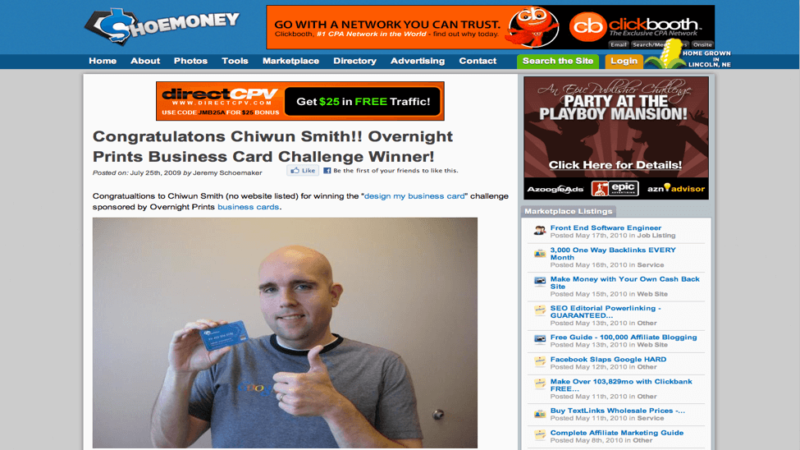
Without a sufficient amount of link authority, Google isn’t going to give your site the time of day. If it seems that despite all your content marketing efforts, the needle just isn’t moving in the Google SERPs, then you’re probably making one of these five avoidable SEO mistakes:
1. Hustling for likes instead of links
Your social strategy is completely misaligned if you aren’t incorporating SEO goals into it. SEO must underpin your social media strategy. It’s not the likes, retweets, shares and plus-ones that are going to prop you up in Google; it’s the links. As such, getting influential bloggers to link to your site should be a primary raison d’être for your social campaigns.
Consider, for example, Old Spice’s gag website TheFlatteringMan.com. The site got plenty of press, but did they put even a single link back to OldSpice.com to leverage their link authority? Nope.


2. Misplacing the content
Remarkable content needs a home where it will attract the most links to your main site, where the links lead directly to your site and not through an intermediary site with lots of links to other folks’ sites, and where the links to your site won’t be nofollowed.
Thus, a social site like YouTube, Pinterest, Twitter, LinkedIn or Facebook is a less-than-ideal home for your content because external links are nofollowed. Even a third-party site like Huffington Post or BuzzFeed can be less than ideal, since you are at the mercy of their editorial guidelines and the number of competing links on the page.
If you wrote a great listicle, you’d think it would be a huge win to get it published on BuzzFeed. It’s not, at least not from an SEO perspective. That’s because BuzzFeed doesn’t allow you to drop links to your site, even if you are a paying advertiser such as Victoria’s Secret.
Victoria’s Secret may have received quite a few views on their “12 Things Women Do Every Day That Are Fearless” piece in BuzzFeed, but take a look, and you will see that there isn’t a single link back to the Victoria’s Secret website. It’s only after you click the author link that you see a link to the main site.
For those of us trying to build up our link authority, the best spot for hosting our linkworthy content will almost always be on our own site.

3. Targeting the wrong audience
This can be tough to wrap your head around, but you already blew it if your content marketing campaign is laser-targeted to your ideal customer.
From an SEO perspective, your most important audience isn’t your customers, it’s the linkerati, i.e., the online influencers who have the most authority in the eyes of Google. Yes, you are going to get the most out of your campaign by targeting those who can link back to you from trusted, authoritative, important sites. If you are only writing content pieces for your customers, you are missing the boat.
Now of course, relevance is still a factor here. If you’re getting a link from a big player in the game design community and you sell yoga clothes, it isn’t going to necessarily be as helpful to you.
To target the linkerati, it becomes as simple (and as complex) as creating content that people want to link to. That sometimes means you’re going to need to think outside the box and branch out a bit from your traditional approach to content. Simply being helpful, useful or educational is not going to cut it. You need to create remarkable content — content worth spreading.
Caterpillar hit it out of the park with their giant Jenga campaign, which featured a video of two CAT machines playing the world’s largest game of Jenga with massive wooden blocks weighing eight tons in total. The video was hosted on YouTube (with almost 3.5 million views!), and CAT cleverly created a page on their site featuring the video to attract links.


ShipServ, on the other hand, lost the content game before it even started with their explainer video made with Legos. Cute concept, but a big disconnect: only serious prospects of their software would want to watch a video explaining how their solution worked.
It didn’t appeal to the army of influencers online, and it shows, with views in the thousands rather than the millions.

LifeInsure.com successfully tapped into an unexpected goldmine of links and buzz with their article, “19 Things You Probably Didn’t Know About Death.” It doesn’t seem like the type of politically correct fare a life insurance brokerage might feature, right?
But, brilliantly, that article wasn’t targeted to customers. In fact, you would never find the article by poking around for it on their site. It’s an orphan page. The intended audience for the article were the linkerati, and it was seeded into social media sites where the linkerati hang out.
The approach paid off in spades. The lifeinsure.com home page ranked on page 1 for “life insurance” in Google, Bing and Yahoo — for years.

4. Being activity-focused
Many SEO practitioners, unfortunately, are task-oriented. They believe that just because it’s a “best practice,” it deserves to be on the to-do list. I challenge that thinking. I’d argue you probably have items on your SEO to-do list that aren’t worth doing and should be removed; they simply aren’t going to move the needle enough.
Or they may be a second-order activity for when you have time after finishing all the first-order activities. Meta descriptions would fit in that category. They don’t influence your rankings, thus they don’t deserve to be prioritized up there with title tags.
Instead, I suggest being outcome-focused: creating a big, hairy, audacious goal, making sure everyone on your team is on board with the goal and systematically working to achieve it. Once the desired outcome has been achieved, come up with a new goal, rather than working through the rest of the to-dos.
5. No help from a power user
Power users are a link builder’s secret weapon. Power users are bloggers, social media mavens, journalists or celebrities with a huge following on social media, and thus, huge reach.
The amplification that power users can provide is game-changing. You don’t need an army of them. All you really need is one power user in your hip pocket.
It can be a challenge to recruit that power user, but once you do, that power user can provide the initial push that starts the snowball effect you need to go viral. In fact, the primary reason for the success of the aforementioned LifeInsure.com campaign was a power user.
Be prepared to pay for that power user, either in cash or in favors. Nothing’s free in this world. If you don’t know how to find that power user, look to your SEO or social media consultant. They may already have a relationship with one.
Over the years, I have developed relationships with power users on reddit, StumbleUpon, Facebook, Twitter, Pinterest and Instagram, among others. Those relationships are worth their weight in gold.
Case in point: Power user Jeremy Schoemaker, aka Shoemoney. I asked, and he agreed, to run a contest in conjunction with my client, OvernightPrints.com. My campaign idea was that an entrant could “Win Free Business Cards for Life” by designing Jeremy’s new business card.
Jeremy is a major online influencer. His promoting the contest and my client on his blog, on YouTube and so on, made a huge and lasting impact. That contest got my client to #2 in Google for “business cards” — and they were buried deep in the SERPs prior to this campaign!

There’s also a surprisingly effective way to do cold outreach to influencers via email, but I’ll save that for my next column.
In that article, I’ll also discuss the wrong language to use in your campaigns, how to collect intel on your competitors and various inadvertent ways to destroy the SEO value of your campaigns.
Some opinions expressed in this article may be those of a guest author and not necessarily Search Engine Land. Staff authors are listed here.
(Some images used under license from Shutterstock.com.)
Let's block ads! (Why?)
